Procedures
Install the MongoDB Enterprise Edition
Installing the MongoDB depends on the operating system on which you are installing it. See the MongoDB documentation for details on how to install MongoDB in your environment. This guide used a RedHat Linux 8 installation. Follow the installation steps in the Install MongoDB Enterprise Edition on Red Hat or CentOS guide from the mongoDB official site.
-
By default, MongoDB instance stores files in the following locations:
-
Data files:
/var/lib/mongo -
Log files:
/var/log/mongodb
-
-
MongoDB runs using the
mongodbuser account.
Validate the MongoDB installation
-
Start MongoDB:
% sudo systemctl start mongod -
Verify that MongoDB has started successfully:
% sudo systemctl status mongod ● mongod.service - MongoDB Database Server Loaded: loaded (/usr/lib/systemd/system/mongod.service; enabled; vendor preset: disabled) Active: active (running) since Thu 2024-03-14 11:56:15 EDT; 19s ago Docs: https://docs.mongodb.org/manual Main PID: 7834 (mongod) Memory: 75.7M CGroup: /system.slice/mongod.service └─7834 /usr/bin/mongod -f /etc/mongod.conf Mar 14 11:56:15 mongodb-kc102-redhat-8 systemd[1]: Started MongoDB Database Server. Mar 14 11:56:16 mongodb-kc102-redhat-8 mongod[7834]: {"t":{"$date":"2024-03-14T15:56:16.008Z"},"s":"I", "c":"CONTROL", "id":7484500, "ctx":"main","msg":"En> -
Stop MongoDB:
% sudo systemctl stop mongod -
Restart MongoDB:
% sudo systemctl restart mongod -
View the log file used by MongoDB at
/var/log/mongodb/mongod.log.You can follow the state of the process for errors or important messages by watching the output in the
/var/log/mongodb/mongod.logfile. -
Begin using MongoDB.
Start a
mongoshsession on the host machine wheremongodis running. You can runmongoshwithout any command-line options to connect to amongodthat is running on your localhost with default port27017. For example:% mongosh Current Mongosh Log ID: 65f45f4b138c69e482b24d1d Connecting to: mongodb://127.0.0.1:27017/?directConnection=true&serverSelectionTimeoutMS=2000&appName=mongosh+2.1.5 Using MongoDB: 7.0.6 Using Mongosh: 2.1.5 For mongosh info see: https://docs.mongodb.com/mongodb-shell/ To help improve our products, anonymous usage data is collected and sent to MongoDB periodically (https://www.mongodb.com/legal/privacy-policy). You can opt-out by running the disableTelemetry() command. ------ The server generated these startup warnings when booting 2024-03-14T11:56:16.710-04:00: Access control is not enabled for the database. Read and write access to data and configuration is unrestricted 2024-03-14T11:56:16.710-04:00: /sys/kernel/mm/transparent_hugepage/enabled is 'always'. We suggest setting it to 'never' 2024-03-14T11:56:16.710-04:00: vm.max_map_count is too low ------ Enterprise test> -
Create a test database:
% Enterprise test> use mydb1; switched to db mydb1 % Enterprise mydb1> db mydb1 -
Insert an entry into the database:
% Enterprise mydb1> db.movie.insertOne({"name":"tutorials point"}) { acknowledged: true, insertedId: ObjectId("60f73d77d932673cb91de215") } -
List the databases:
> Enterprise mydb1> show dbs admin 40.00 KiB config 12.00 KiB local 72.00 KiB mydb1 40.00 KiB -
Drop the test database:
% Enterprise mydb1> db.dropDatabase() { ok: 1, dropped: 'mydb1' }
If you were able to create the database and perform the commands above, the installation is validated.
Install and configure Entrust KeyControl Vault
To install and configure Entrust KeyControl Vault, follow the installation and setup instructions in the Entrust KeyControl Vault nShield HSM Integration Guide. You can access it from the Entrust Document Library and from the nShield Product Documentation website.
| MongoDB requires the KMIP server to support TLS 1.2. Make sure Restrict TLS is enabled when enabling KMIP at the Entrust KeyControl Vault Server. |
Creating a KMIP Vault on Entrust KeyControl Vault Management Interface
The KeyControl Vault appliance supports different type of vaults that can be used by all type of applications. This section describes how to create a KMIP Vault in the KeyControl Vault Server.
Refer to the Creating a Vault section of the admin guide for more details about it.
-
Log into the KeyControl Vault Server web user interface:
-
Use your browser to access the IP address of the server.
-
Sign in using the secroot credentials.
-
-
If not in the Vault Management interface, select SWITCH TO: Manage Vaults in the Menu Header.
This action will take you to the KeyControl Vault Management interface.
-
In the KeyControl Vault Management interface, select Create Vault.
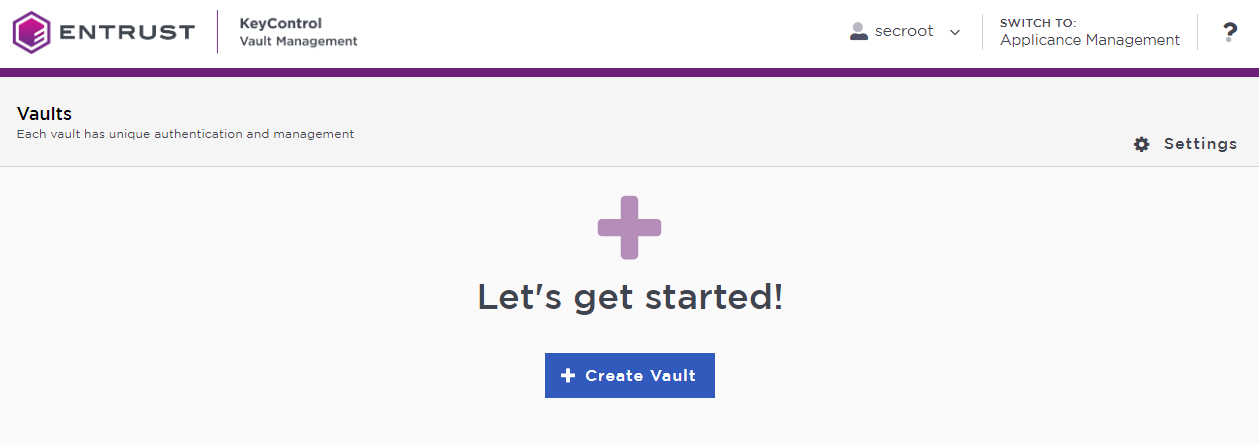
KeyControl Vault supports the following types of vaults:
-
Cloud Key Management - Vault for cloud keys such as BYOK and HYOK.
-
KMIP - Vault for KMIP Objects.
-
PASM - Vault for objects such as passwords, files, SSH keys, and so on.
-
Database - Vault for database keys.
-
Tokenization - Vault for tokenization policies.
-
VM Encryption - Vault for encrypting VMs.
-
-
In the Create Vault page, create a KMIP Vault:
-
For Type, select KMIP.
-
For Name, enter the name of the Vault.
-
For Description, enter the description of the Vault.
-
For Admin Name, enter the name of the administrator of the Vault.
-
For Admin Email, enter a valid email for the administrator.
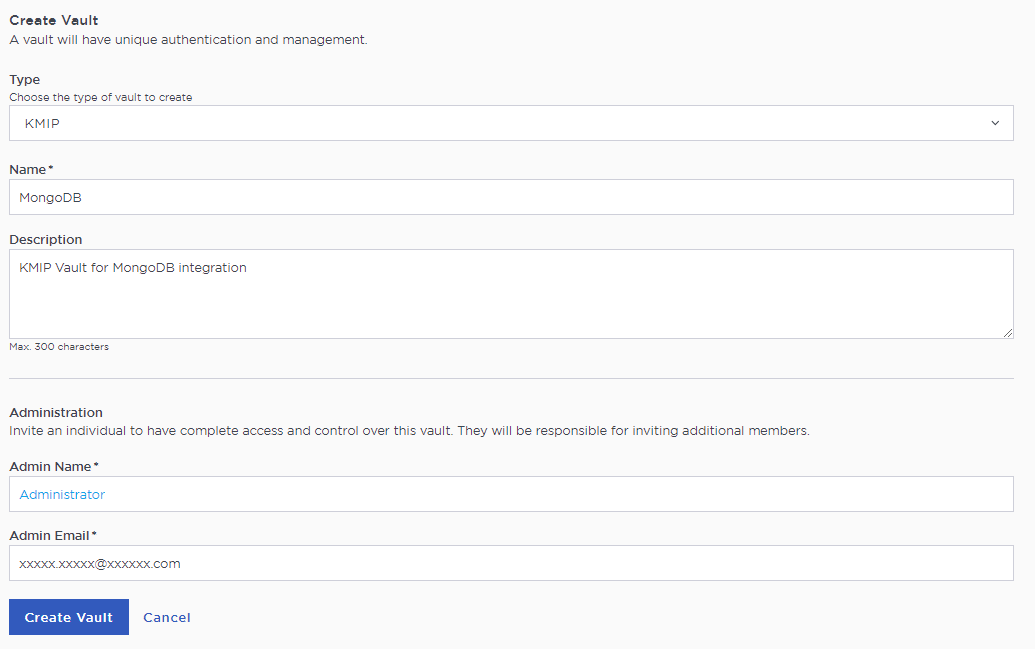
A temporary password will be emailed to the administrator’s email address. This is the password that will be used to sign in for the first time to the KMIP Vaults space in KeyControl. In a closed gap environment where email is not available, the password for the user is displayed when you first create the vault. That can be copied and sent to the user.
-
-
Select Create Vault.
-
Select Close when the Vault creation completes.
-
The newly-created Vault is added to the Vault dashboard.
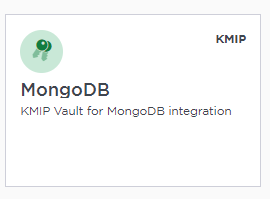
-
After the Vault has been created, the KMIP server settings on the appliance are enabled.
KMIP server settings
The KMIP server settings are set at the KeyControl appliance level and apply to all the KMIP Vaults in the appliance. After a KMIP Vault is created, they are automatically set to ENABLED.
To use external key management and configure the KeyControl Vault KMIP settings, refer to the KMIP Client and Server Configuration section of the admin guide.
| When using external key management, as is the case in this solution, the KeyControl server is the KMIP server and the MongoDB server is the KMIP client. |
-
Select the Settings icon on the top right to view/change the KMIP settings.
-
The defaults settings are appropriate for most applications.
-
Make sure Restrict TLS is enabled.
-
Make any changes necessary.
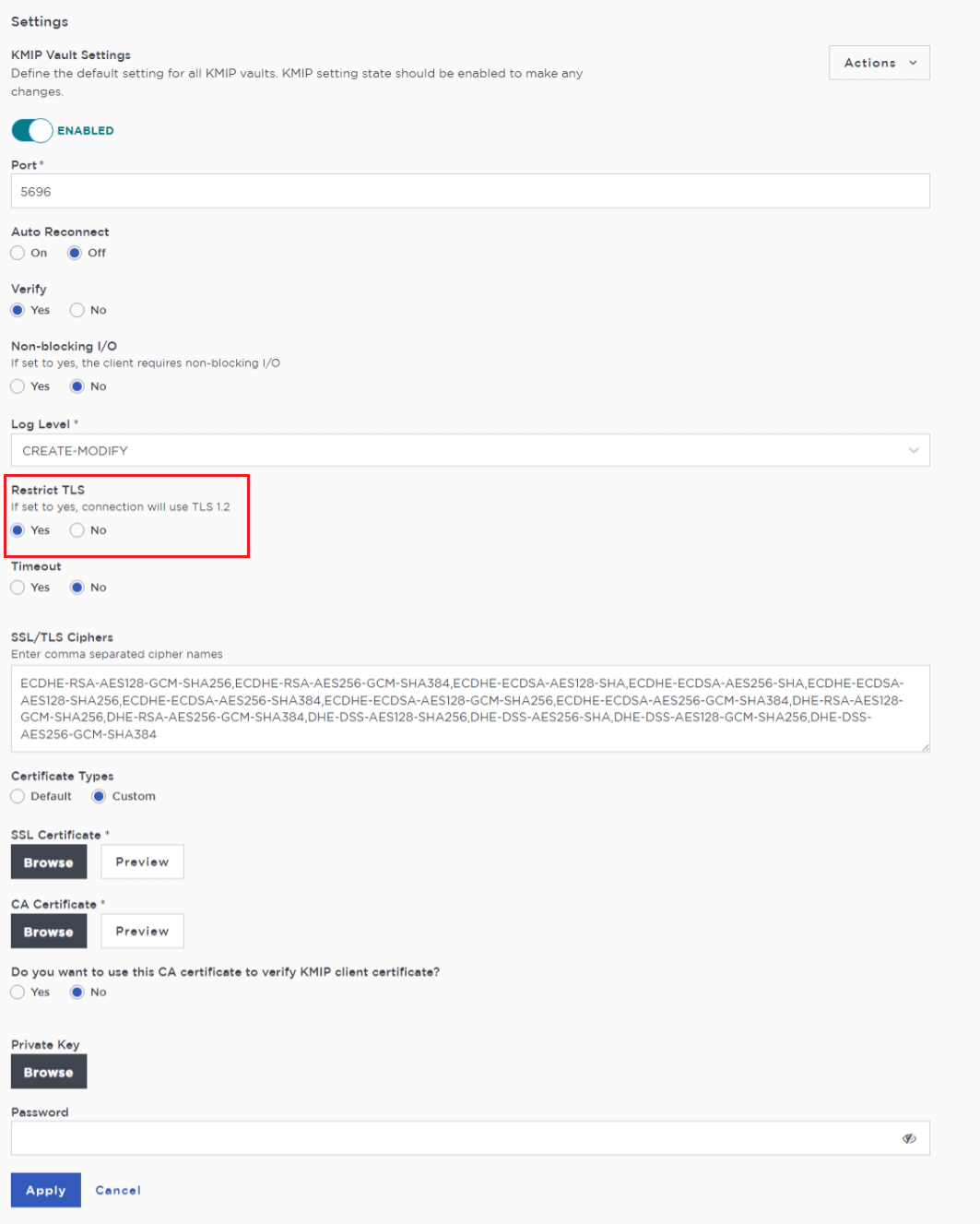
MongoDB requires the KMIP server to support TLS 1.2. Make sure Restrict TLS is enabled as shown above.
-
-
Select Apply.
View details for the Vault
To view the details on the Vault, select View Details when you hover over the Vault.
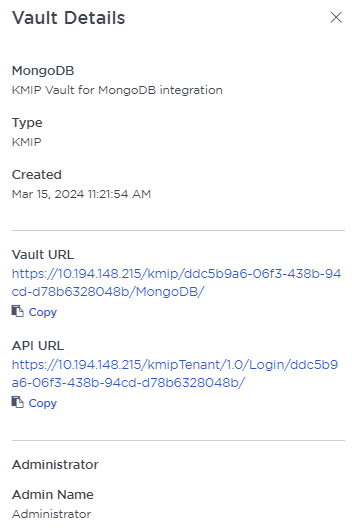
Establishing trust between the KeyControl Vault Server and MongoDB
Certificates are required to facilitate the KMIP communications from the KeyControl KMIP Vault and the MongoDB application and conversely. The built-in capabilities in the KeyControl KMIP Vault are used to create and publish the certificates.
For more information on how to create a certificate bundle, refer to Establishing a Trusted Connection with a KeyControl Vault-Generated CSR.
The process below will show how to integrate MongoDB encryption with KeyControl KMIP Vault.
-
Sign in to the KMIP Vault created earlier. Use the login URL and credentials provided to the administrator of the Vault.
-
Select Security, then Client Certificates.
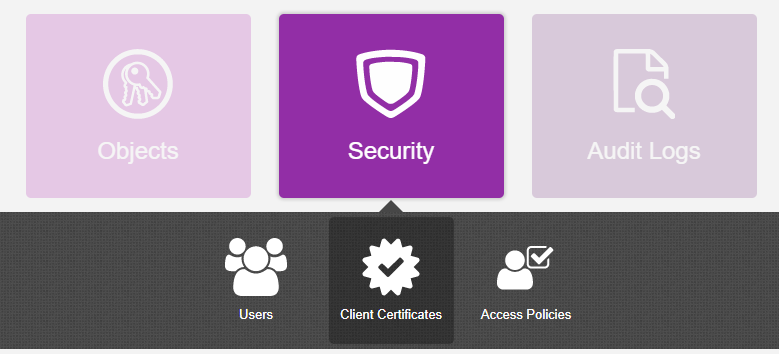
-
In the Manage Client Certificate page, select the + icon on the right to create a new certificate.
-
In the Create Client Certificate dialog box:
-
Enter a name in the Certificate Name field.
-
Set the date on which you want the certificate to expire in the Certificate Expiration field.
-
Select Create.
The new certificates are added to the Manage Client Certificate pane.
-
-
Select the certificate and select the Download icon to download the certificate.
The webGUI downloads
certname_datetimestamp.zip, which contains a user certification/key file calledcertname.pemand a server certification file calledcacert.pem. -
Unzip the file so that you have the
certname.pemfile available to upload. -
The download zip file contains the following:
-
A
certname.pemfile that includes both the client certificate and private key. In this example, this file is calledmongodb.pem.The client certificate section of the
certname.pemfile includes the lines “-----BEGIN CERTIFICATE-----" and “-----END CERTIFICATE-----" and all text between them.The private key section of the
certname.pemfile includes the lines “-----BEGIN PRIVATE KEY-----" and “-----END PRIVATE KEY-----" and all text in between them. -
A
cacert.pemfile which is the root certificate for the KMS cluster. It is always namedcacert.pem.
These files will be used in the MongoDB configuration next.
-
Configure MongoDB Server Security options to use KMIP
Add Key Management Security Options to /etc/mongod.conf.
The MongoDB configuration file contains a security section.
In this section the server name, certificate details, KMIP port number and encryption cipher information must be updated to use KeyControl as a key management service.
-
Copy the certificate files to a location on the server that they can be used by MongoDB. For example, in your home directory:
% sudo mkdir -p /opt/mongodb/security % sudo cp ~/mongodb.pem /opt/mongodb/security % sudo cp ~/cacert.pem /opt/mongodb/security % sudo chmod 644 /opt/mongodb/security/* -
Open the
/etc/mongod.conffile and add the key management configuration options described below:security: enableEncryption: true encryptionCipherMode: AES256-GCM kmip: serverName: kcv-10-2-node-1.interop.local,kcv-10-2-node-2.interop.local port: 5696 clientCertificateFile: /opt/mongodb/security/mongodb.pem serverCAFile: /opt/mongodb/security/cacert.pemIn this example:
- enableEncryption
-
Sets the flag to enable encryption to the database.
- encryptionCipherMode
-
Sets the cipher used. If you are using Linux, select either AES256-GCM or AES256-CBC. For other OSs, only AES256-CBC is available.
- serverName
-
Hostname of KeyControl operating as the KMS KMIP server. This hostname must match the hostname used in the
/etc/hostsfile and cannot be an IP address. The hostname must also contain the subdomain. You can specify multiple KMIP servers as a comma-separated list:server1.example.com,server2.example.com. On startup, themongodwill attempt to establish a connection to each server in the order listed, and will select the first server to which it can successfully establish a connection. KMIP server selection occurs only at startup. - port
-
Contains the KMIP port number. Port 5696 is the default port assignment for KMIP communication and is the KMIP port used by KeyControl.
- clientCertificateFile
-
Contains the directory/file location of the client certificate used for authenticating MongoDB to the KMIP server.
- serverCAFile
-
Contains the directory/file location of the KeyControl root CA certificate.
Add information to the /etc/hosts file
When you added the security section to the mongod.conf file, add the KeyControl hostname.domainname to the /etc/hosts file to resolve the IP address of the KMIP server to the hostname.
The hostname must match the hostname used in the mongod.conf and cannot be an IP address.
The hostname must also contain the subdomain.
Allowing MongoDB to talk to KeyControl on port 5696
Port 5696 needs to be allowed in selinux configuration so mondobd can reach the KeyControl vault server. If you don’t do this, mongodb will fail to start with messages like this:
{"t":{"$date":"2024-03-18T12:26:46.836-04:00"},"s":"W", "c":"STORAGE", "id":24240, "ctx":"initandlisten","msg":"Connection to KMIP server failed. Trying next server","attr":{"failedHost":"kcv-10-2-node-1.interop.local:5696","nextHost":"kcv-10-2-node-2.interop.local:5696"}}
{"t":{"$date":"2024-03-18T12:26:46.837-04:00"},"s":"W", "c":"NETWORK", "id":23190, "ctx":"initandlisten","msg":"Failed to connect to remote host","attr":{"remoteSocketAddress":"10.194.148.216","remoteSocketAddressPort":5696,"call":"connect","error":"Permission denied"}}
{"t":{"$date":"2024-03-18T12:26:46.837-04:00"},"s":"E", "c":"STORAGE", "id":24248, "ctx":"initandlisten","msg":"Unable to retrieve key","attr":{"keyId":".system","error":{"code":2,"codeName":"BadValue","errmsg":"Could not connect to KMIP server 10.194.148.216:5696"}}}
{"t":{"$date":"2024-03-18T12:26:46.847-04:00"},"s":"W", "c":"NETWORK", "id":23190, "ctx":"initandlisten","msg":"Failed to connect to remote host","attr":{"remoteSocketAddress":"10.194.148.215","remoteSocketAddressPort":5696,"call":"connect","error":"Permission denied"}}
{"t":{"$date":"2024-03-18T12:26:46.847-04:00"},"s":"W", "c":"STORAGE", "id":24240, "ctx":"initandlisten","msg":"Connection to KMIP server failed. Trying next server","attr":{"failedHost":"kcv-10-2-node-1.interop.local:5696","nextHost":"kcv-10-2-node-2.interop.local:5696"}}
{"t":{"$date":"2024-03-18T12:26:46.847-04:00"},"s":"W", "c":"NETWORK", "id":23190, "ctx":"initandlisten","msg":"Failed to connect to remote host","attr":{"remoteSocketAddress":"10.194.148.216","remoteSocketAddressPort":5696,"call":"connect","error":"Permission denied"}}
{"t":{"$date":"2024-03-18T12:26:46.847-04:00"},"s":"E", "c":"STORAGE", "id":24248, "ctx":"initandlisten","msg":"Unable to retrieve key","attr":{"keyId":".system","error":{"code":2,"codeName":"BadValue","errmsg":"Could not connect to KMIP server 10.194.148.216:5696"}}}Open up port 5696 on selinux using the following command:
% sudo semanage port -a -t http_port_t -p tcp 5696Test configuration
Once you have finished configuring the mongod.conf and hosts files, start MongoDB.
When started, MongoDB will attempt to retrieve an encryption key stored on KeyControl.
If MongoDB does not find a key, it creates one and stores it in KeyControl.
% sudo systemctl restart mongod
% sudo systemctl status mongod
● mongod.service - MongoDB Database Server
Loaded: loaded (/usr/lib/systemd/system/mongod.service; enabled; vendor preset: disabled)
Active: active (running) since Mon 2024-03-18 12:36:56 EDT; 8s ago
Docs: https://docs.mongodb.org/manual
Main PID: 1811904 (mongod)
Memory: 82.2M
CGroup: /system.slice/mongod.service
└─1811904 /usr/bin/mongod -f /etc/mongod.conf
Mar 18 12:36:56 mongodb-kc102-redhat-8 systemd[1]: Started MongoDB Database Server.
Mar 18 12:36:56 mongodb-kc102-redhat-8 mongod[1811904]: {"t":{"$date":"2024-03-18T16:36:56.841Z"},"s":"I", "c":"CONTROL", "id":7484500, "ctx":"main","msg":"Environment variable MONGODB>
If you try enable encryption on an existing instance of MongoDB and data already exists in the MongoDB data directory /var/lib/mongo, you will get an error when you start the mongod service.
You can only have encryption enabled in a blank data directory.
See Enable encryption on an existing MongoDB instance for instructions on how to get around the issue.
|
To confirm that the master key was successfully created, log in to KeyControl Tenant URL (KMIP Login) and look under Objects as shown below.

You should see the master key that you have just created.
Verify that the encryption is working and that MongoDB is using KeyControl to manage the keys
You can use the following procedures to validate that encryption is working and that KeyControl is being used by MongoDB.
Test access when KeyControl is available
To test access:
-
Stop the network services on the MongoDB server and try to restart the
mongodservice.The
mongodservice will not start because it cannot connect to one of the KeyControl servers. For example:% sudo systemctl restart mongod % sudo systemctl status mongod ● mongod.service - MongoDB Database Server Loaded: loaded (/usr/lib/systemd/system/mongod.service; enabled; vendor preset: disabled) Active: failed (Result: exit-code) since Mon 2024-03-18 13:39:23 EDT; 19s ago Docs: https://docs.mongodb.org/manual Process: 1832247 ExecStart=/usr/bin/mongod $OPTIONS (code=exited, status=14) Main PID: 1832247 (code=exited, status=14) Mar 18 13:39:22 mongodb-kc102-redhat-8 systemd[1]: Started MongoDB Database Server. Mar 18 13:39:22 mongodb-kc102-redhat-8 mongod[1832247]: {"t":{"$date":"2024-03-18T17:39:22.514Z"},"s":"I", "c":"CONTROL", "id":7484500, "ctx":"main","msg":"Environment variable MONGODB_CONFIG_OVERRIDE_NOFORK == 1, overriding \"processManagement.fork\" to false"} Mar 18 13:39:23 mongodb-kc102-redhat-8 systemd[1]: mongod.service: Main process exited, code=exited, status=14/n/a Mar 18 13:39:23 mongodb-kc102-redhat-8 systemd[1]: mongod.service: Failed with result 'exit-code'. -
Restart the network services and try again. The
mongodservice starts successfully.● mongod.service - MongoDB Database Server Loaded: loaded (/usr/lib/systemd/system/mongod.service; enabled; vendor preset: disabled) Active: active (running) since Mon 2024-03-18 13:42:27 EDT; 5s ago Docs: https://docs.mongodb.org/manual Main PID: 1832593 (mongod) Memory: 178.8M CGroup: /system.slice/mongod.service └─1832593 /usr/bin/mongod -f /etc/mongod.conf Mar 18 13:42:27 mongodb-kc102-redhat-8 systemd[1]: Started MongoDB Database Server. Mar 18 13:42:27 mongodb-kc102-redhat-8 mongod[1832593]: {"t":{"$date":"2024-03-18T17:42:27.171Z"},"s":"I", "c":"CONTROL", "id":7484500, "ctx":"main","msg":"Environment variable MONGODB_CONFIG_OVERRIDE_NO
| When MongoDB is encrypted, it is only accessible when KeyControl is available and master key is found. |
Validate access when a KeyControl node in the cluster is not available
To validate access:
-
Bring down one of the KeyControl nodes and check that you can access MongoDB. For example:

-
Attempt to start up
mongodwhen one of the KeyControl nodes in the cluster is down:% sudo systemctl restart mongod % sudo systemctl status mongod ● mongod.service - MongoDB Database Server Loaded: loaded (/usr/lib/systemd/system/mongod.service; enabled; vendor preset: disabled) Active: active (running) since Mon 2024-03-18 13:56:50 EDT; 15s ago Docs: https://docs.mongodb.org/manual Main PID: 1837551 (mongod) Memory: 181.0M CGroup: /system.slice/mongod.service └─1837551 /usr/bin/mongod -f /etc/mongod.conf Mar 18 13:56:50 mongodb-kc102-redhat-8 systemd[1]: mongod.service: Succeeded. Mar 18 13:56:50 mongodb-kc102-redhat-8 systemd[1]: Stopped MongoDB Database Server. Mar 18 13:56:50 mongodb-kc102-redhat-8 systemd[1]: Started MongoDB Database Server. Mar 18 13:56:51 mongodb-kc102-redhat-8 mongod[1837551]: {"t":{"$date":"2024-03-18T17:56:51.027Z"},"s":"I", "c":"CONTROL", "id":7484500, "ctx":"main","msg":"Environment variable MONGODB_CONFIG_OVERRIDE_NO>
When one of its nodes is down, the KeyControl cluster goes out of Healthy status.
New keys can only be created when the cluster is in Healthy status.
Therefore, rotating keys should not be attempted when one of the nodes in the cluster is down.
|
Rotate the master key in KeyControl with MongoDB
You can rotate the master key, the only externally managed key. With the new master key, the internal keystore will be re-encrypted but the database keys will be otherwise left unchanged. This obviates the need to re-encrypt the entire data set.
-
Stop the
mongodservice:% sudo systemctl stop mongod -
Add the following to
/etc/mongod.confunder thekmipsettings:kmip: rotateMasterKey: true -
Start the
mongodservice:% sudo systemctl start mongod -
Upon successful completion of the master key rotation and re-encryption of the database keystore, a new master key will be created in KeyControl.
-
Remove the
kmip rotateMasterKeysetting from the/etc/mongod.conffile by commenting it out:kmip: # rotateMasterKey: true -
Restart the
mongodservice:> sudo systemctl restart mongod > sudo systemctl status mongod ● mongod.service - MongoDB Database Server Loaded: loaded (/usr/lib/systemd/system/mongod.service; enabled; vendor preset: disabled) Active: active (running) since Mon 2024-03-18 14:15:44 EDT; 6s ago Docs: https://docs.mongodb.org/manual Main PID: 1842217 (mongod) Memory: 177.1M CGroup: /system.slice/mongod.service └─1842217 /usr/bin/mongod -f /etc/mongod.conf Mar 18 14:15:44 mongodb-kc102-redhat-8 systemd[1]: Started MongoDB Database Server. Mar 18 14:15:44 mongodb-kc102-redhat-8 mongod[1842217]: {"t":{"$date":"2024-03-18T18:15:44.466Z"},"s":"I", "c":"CONTROL", "id":7484500, "ctx":"main","msg":"Environment variable MONGODB_CONFIG_OVERRIDE_NO> -
When the key is rotated, check on KeyControl if the master key is rotated.
To confirm that the new master key was successfully created, log in to KeyControl KMIP Vault URL, look under Objects. For example:

You will find a new key created in KeyControl. You should also be able to see the creation of the key in the KeyControl Audit Logs. For example:

Enable encryption on an existing MongoDB instance
If you try to enable encryption on an existing instance of MongoDB and data already exists in the MongoDB data directory /var/lib/mongo, you should see an error when you start the mongod service.
For example:
● mongod.service - MongoDB Database Server
Loaded: loaded (/usr/lib/systemd/system/mongod.service; enabled; vendor preset: disabled)
Active: failed (Result: exit-code) since Mon 2024-03-18 14:29:03 EDT; 5s ago
Docs: https://docs.mongodb.org/manual
Process: 1846502 ExecStart=/usr/bin/mongod $OPTIONS (code=exited, status=14)
Main PID: 1846502 (code=exited, status=14)
Mar 18 14:29:02 mongodb-kc102-redhat-8 systemd[1]: mongod.service: Succeeded.
Mar 18 14:29:02 mongodb-kc102-redhat-8 systemd[1]: Stopped MongoDB Database Server.
Mar 18 14:29:02 mongodb-kc102-redhat-8 systemd[1]: Started MongoDB Database Server.
Mar 18 14:29:02 mongodb-kc102-redhat-8 mongod[1846502]: {"t":{"$date":"2024-03-18T18:29:02.572Z"},"s":"I", "c":"CONTROL", "id":7484500, "ctx":"main","msg":"Environment variable MONGODB_CONFIG_OVERRIDE_NO>
Mar 18 14:29:03 mongodb-kc102-redhat-8 systemd[1]: mongod.service: Main process exited, code=exited, status=14/n/a
Mar 18 14:29:03 mongodb-kc102-redhat-8 systemd[1]: mongod.service: Failed with result 'exit-code'.When you look in /var/log/mongodb/mongod.log for what may be causing the failure, you should see errors.
For example:
{"t":{"$date":"2024-03-18T14:29:03.157-04:00"},"s":"E", "c":"STORAGE", "id":24248, "ctx":"initandlisten","msg":"Unable to retrieve key","attr":{"keyId":".system","error":{"code":2,"codeName":"BadValue","errmsg":"There are existing data files, but no valid keystore could be located."}}}
{"t":{"$date":"2024-03-18T14:29:03.167-04:00"},"s":"E", "c":"STORAGE", "id":24248, "ctx":"initandlisten","msg":"Unable to retrieve key","attr":{"keyId":".system","error":{"code":2,"codeName":"BadValue","errmsg":"There are existing data files, but no valid keystore could be located."}}}
{"t":{"$date":"2024-03-18T14:29:03.176-04:00"},"s":"E", "c":"STORAGE", "id":24248, "ctx":"initandlisten","msg":"Unable to retrieve key","attr":{"keyId":".system","error":{"code":2,"codeName":"BadValue","errmsg":"There are existing data files, but no valid keystore could be located."}}}The error clearly states that the data files are present in the db path without any key store.
This translates to how it works with mongodb - you can only have encryption enabled in a blank data directory.
You can achieve this by taking the backup, stopping the mongod instance, clearing the data directory, restarting by enabling encryption and then restore from backup.
-
If you already added the security section to
/etc/mongod.conf, comment it out:#security: # enableEncryption: true # encryptionCipherMode: AES256-GCM # kmip: # serverName: kcv-10-2-node-1.interop.local,kcv-10-2-node-2.interop.local # port: 5696 # clientCertificateFile: /opt/mongodb/security/mongodb.pem # serverCAFile: /opt/mongodb/security/cacert.pem -
Restart the
mongodservice:% sudo systemctl restart mongod % sudo systemctl status mongod ● mongod.service - MongoDB Database Server Loaded: loaded (/usr/lib/systemd/system/mongod.service; enabled; vendor preset: disabled) Active: active (running) since Mon 2024-03-18 14:33:12 EDT; 8s ago Docs: https://docs.mongodb.org/manual Main PID: 1846611 (mongod) Memory: 170.5M CGroup: /system.slice/mongod.service └─1846611 /usr/bin/mongod -f /etc/mongod.conf Mar 18 14:33:12 mongodb-kc102-redhat-8 systemd[1]: Started MongoDB Database Server. Mar 18 14:33:12 mongodb-kc102-redhat-8 mongod[1846611]: {"t":{"$date":"2024-03-18T18:33:12.565Z"},"s":"I", "c":"CONTROL", "id":7484500, "ctx":"main","msg":"Environment variable MONGODB_CONFIG_OVERRIDE_NO> -
Make a backup of the data:
% sudo mkdir -p /data/backup % sudo mongodump --out=/data/backup 2024-03-18T14:34:07.023-0400 writing admin.system.version to /data/backup/admin/system.version.bson 2024-03-18T14:34:07.024-0400 done dumping admin.system.version (1 document) 2024-03-18T14:34:07.025-0400 writing mydb1.movie to /data/backup/mydb1/movie.bson 2024-03-18T14:34:07.027-0400 done dumping mydb1.movie (1 document) -
Put the security section back in
/etc/mongod.conf:security: enableEncryption: true encryptionCipherMode: AES256-GCM kmip: serverName: kcv-10-2-node-1.interop.local,kcv-10-2-node-2.interop.local port: 5696 clientCertificateFile: /opt/mongodb/security/mongodb.pem serverCAFile: /opt/mongodb/security/cacert.pem -
Clean up the data directory
/var/lib/mongoand remove all files and directories:% cd /var/lib % cp -rp mongo mongo.backup % rm -rf mongo/* -
Restart the
mongodservice:% sudo systemctl restart mongod % sudo systemctl status mongod ● mongod.service - MongoDB Database Server Loaded: loaded (/usr/lib/systemd/system/mongod.service; enabled; vendor preset: disabled) Active: active (running) since Mon 2024-03-18 14:36:07 EDT; 6s ago Docs: https://docs.mongodb.org/manual Main PID: 1847541 (mongod) Memory: 72.9M CGroup: /system.slice/mongod.service └─1847541 /usr/bin/mongod -f /etc/mongod.conf Mar 18 14:36:07 mongodb-kc102-redhat-8 systemd[1]: Started MongoDB Database Server. Mar 18 14:36:07 mongodb-kc102-redhat-8 mongod[1847541]: {"t":{"$date":"2024-03-18T18:36:07.973Z"},"s":"I", "c":"CONTROL", "id":7484500, "ctx":"main","msg":"Environment variable MONGODB_CONFIG_OVERRIDE_NO> -
Restore the backup:
% sudo mongorestore /data/backup 2024-03-18T14:37:22.551-0400 preparing collections to restore from 2024-03-18T14:37:22.552-0400 reading metadata for mydb1.movie from /data/backup/mydb1/movie.metadata.json 2024-03-18T14:37:22.569-0400 restoring mydb1.movie from /data/backup/mydb1/movie.bson 2024-03-18T14:37:22.580-0400 finished restoring mydb1.movie (1 document, 0 failures) 2024-03-18T14:37:22.580-0400 no indexes to restore for collection mydb1.movie 2024-03-18T14:37:22.580-0400 1 document(s) restored successfully. 0 document(s) failed to restore.
The existing data should be now protected by encryption.